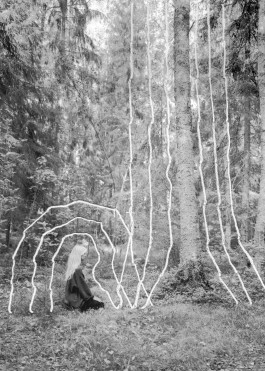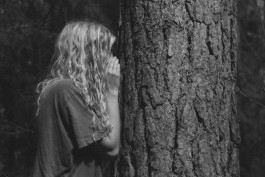
kanto
(2022 – ongoing)
The work explores the transience and transformation of landscapes and their effects on the human mind and body. At the center of the work lies a deep attachment to the slowly vanishing nature surrounding a childhood home. The forest, which has long provided a sense of belonging and security, is becoming a reflection of the cycle of life and death, leading to a reevaluation of the identity once shaped by the surrounding nature – trees, lakes, and various species.
The Finnish word “kanto,” which means both a tree stump and carrying, refers to the reciprocal care between humans and other forms of life. Amid the national discussion in Finland on logging, deforestation and species loss, the impacts of changing landscapes are visible in many parts of the country, but also deep within ourselves – the landscape we call home is shrinking into an unrecognisable non-place. From an ecofeminist perspective our bodies are part of these places and extensions of the nature that has raised us, regardless of where we are.
According to the American feminist theorist and scholar Donna Haraway, grief is an essential part of cultivating response-ability – it opens up possibilities for various reactions and increases the willingness to acknowledge the existence of a world beyond oneself. Indigenous beliefs suggest that the souls of deceased loved ones transfer to the surrounding trees, making the loss of a familiar forest comparable to losing a cherished person. As part of a grieving process, the work explores grief as a pathway to understanding the intertwining of life and death.
Through rituals and a bodily working method, the work seeks to build reciprocity and strengthen the connection to the land. The series consists of pigment and silver gelatine prints that emphasise the themes of the passage of time and transience. As an intervention, the weaving in the works plays a role in expressing care and inclusion, reflecting both cosmic and hereditary interspecies interactions. The works recognise nature and soil as the body’s home, linking them to feminine power and reflecting a desire to return to a state of original unity. Kanto acts both as a protest against the logging and destruction of familiar landscapes and as a reaffirmation of existence: the body becomes a testament to belonging.









kanto
(2022 – ongoing)
The work explores the transience and transformation of landscapes and their effects on the human mind and body. At the center of the work lies a deep attachment to the slowly vanishing nature surrounding a childhood home. The forest, which has long provided a sense of belonging and security, is becoming a reflection of the cycle of life and death, leading to a reevaluation of the identity once shaped by the surrounding nature – trees, lakes, and various species.
The Finnish word “kanto,” which means both a tree stump and carrying, refers to the reciprocal care between humans and other forms of life. Amid the national discussion in Finland on logging, deforestation and species loss, the impacts of changing landscapes are visible in many parts of the country, but also deep within ourselves – the landscape we call home is shrinking into an unrecognisable non-place. From an ecofeminist perspective our bodies are part of these places and extensions of the nature that has raised us, regardless of where we are.
According to the American feminist theorist and scholar Donna Haraway, grief is an essential part of cultivating response-ability – it opens up possibilities for various reactions and increases the willingness to acknowledge the existence of a world beyond oneself. Indigenous beliefs suggest that the souls of deceased loved ones transfer to the surrounding trees, making the loss of a familiar forest comparable to losing a cherished person. As part of a grieving process, the work explores grief as a pathway to understanding the intertwining of life and death.
Through rituals and a bodily working method, the work seeks to build reciprocity and strengthen the connection to the land. The series consists of pigment and silver gelatine prints that emphasise the themes of the passage of time and transience. As an intervention, the weaving in the works plays a role in expressing care and inclusion, reflecting both cosmic and hereditary interspecies interactions. The works recognise nature and soil as the body’s home, linking them to feminine power and reflecting a desire to return to a state of original unity. Kanto acts both as a protest against the logging and destruction of familiar landscapes and as a reaffirmation of existence: the body becomes a testament to belonging.

